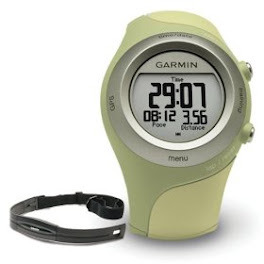The majority of GPS watches are targeted at runners. They can be used in other types of sport like cycling, skiing and rowing just as easily, but by far the biggest group of users of GPS watch systems are runners of all levels, which begs the question - especially if you are a runner yourself - just which is the best GPS running watch out there?
It's a good question and the answer will depenend on just what you are looking for specifically in a complete sports running watch.
These days, almost all running watch manufactures produce watches that support GPS. But the way they do this is what sets them apart. Probably the best advice I could give is to choose a watch system that you like and would use if you did not require GPS at all and then buy a GPS from that manufacturer.
But a lot depends on why you want GPS in the first place. If you just want a speed and distance system, then this advice is probably spot on, however if you want advanced features like the ability to record your courses and view them in software, then you might be better of with a watch like the Garmin Forerunner, which is specifically designed as a GPS watch, rather than a sports watch with GPS tacked on.
Anyhow here is a brief comparison of the leading running watch brands and how their GPs systems rate.
Garmin Forerunner
Garmin Forerunner offer the larget range of features in a GPS running watch by far. They are also, currently the most popular. The Garmin watches are one-piece GPS systems and feature nearly every feature a runner could require. On the negative side, they are not the most intuitive sports watch available, they offer a one-piece GPS system and due to this the watchpieces are quite bulky due to the requirement that the GPS aerial must be mounted within the wristwatch. They are over-kill if you are not prepared to take the time to learn all the features.
The most recently released Foreruners include:
- Forerunner 405CX
- Forerunner 310XT
Also look out for the older Forerunner 305 if you require routes, as the 310XT has dropped this feature.
Timex Bodylink (and new Global Trainer)
Timex GPS watches have up until now required you attach an external GPS device to your body. The device, which requires a AA batteries, links up to the GPS satellites and wirelessly transmit global positioning data to the Timex wristwatch.
Timex still offer a line of GPS watches known as speed and distance, although this line is being quickly phased out. The speed+distance watches offer 2D GPS tracking, so simply measure speed, pace distance and nothing else. Timex's more sophisticated (and more expensive) Bodylink watches deliver 3D GPS, so can present you with elevation data as well as flat line speed and distance. There is little ability to view courses in a3D may, however using the Timex data recorder (purchased seperately) with third party software can achieve this result.
To sum up, Timex GPS watches are generally easier and more intuitive to use than other sports watch GPS systems, but require you to attach an external device to your body and replace the batteries on a regular basis. Timex GPS watches offer you some neat benefits, but lack the full range of features delivered in the Garmin Forunner watches. If you already use and enjoy Timex watches then a Timex Bodylink watch can be a great buy.
Suunto Training Series
The Suunto Training Series is a collection of sophisticated running and fitness watches that feature four models, the t1c, t3c, t4c and t6c. The t1c does not support GPS, but the rest offer you the choice of using a 2D GPS add-on pod or a foot pod. Like the Timex GPS watches it is external and must be attached to the body. The Suunto Training Series watches should not be purchased for their GPS abilities alone, although the t6c does offer elevation features, but uses a built-in barometric altimeter for this rather than GPS. This is not a disadvantage as a barometeric altimeter is a more accurate way of measuring height than GPS, but unlike the Forerunner the t6c cannot record route maps that are viewable in software. The Suunto training series watches are a great choice for the fitness features based on their own merits.
Discover more about the Suunto Training Series watches here. Suunto Trainig Series.
Polar GPS Watches
Like the Suunto and Timex GPS watches, GPS in polar watches is a component that is added to their existing sports running watch and is worn externally from the wristwatch. Polar watches also support an accelerometer foot pod, which measures speed, pace and distance information accurately, and does not suffer signal obstruction like a GPS watch, but lacks route mapping.
Polar GPS watches come in two general varieties, the G1 GPS Sensor and G3 GPS sensor. The G1 GPS sensor simply measures speed and distance, but not route mapping or elevation data. The G3 GPS sensor does facilitate these extra features.
Both variations offer target zones. The Polar running watches that support GPS include:
Many of Polar's general fitness watches support the G1 GPS sensor too.
The best general GPS running watch - or watches is currently the Garmin Forerunner, that is designed specifically as a GPS watch and pitched with runners in mind. The new Timex Global Trainer GPS watch might change that when it is released (it is due in early 2010). The best running GPS watch for your needs will probably depend on the other features you need and your price range. Best advice I can offer is to find a watch manufacturer you like that suits you and buy one of its GPS-enabled watches.
For more information you might also want to check out this article:

